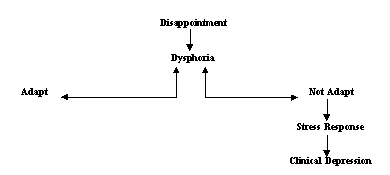

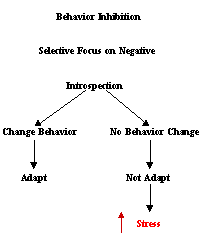
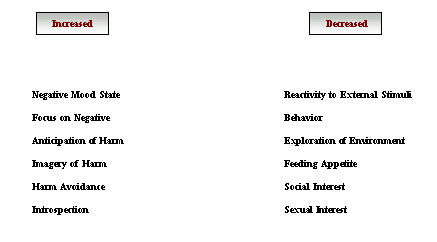
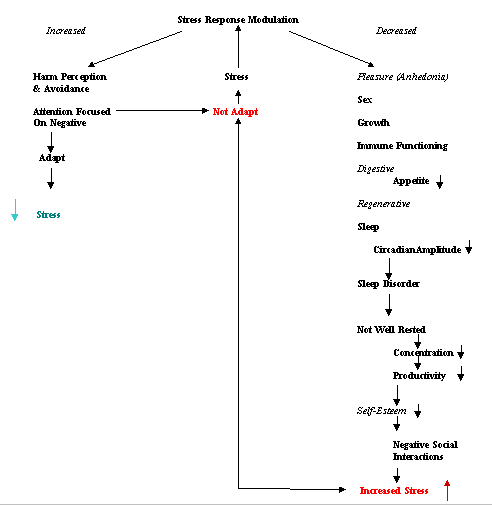
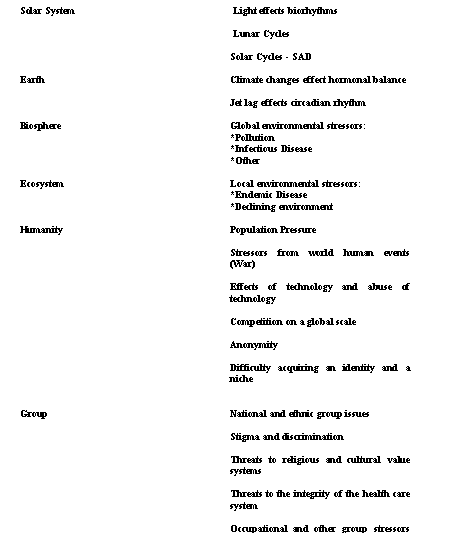
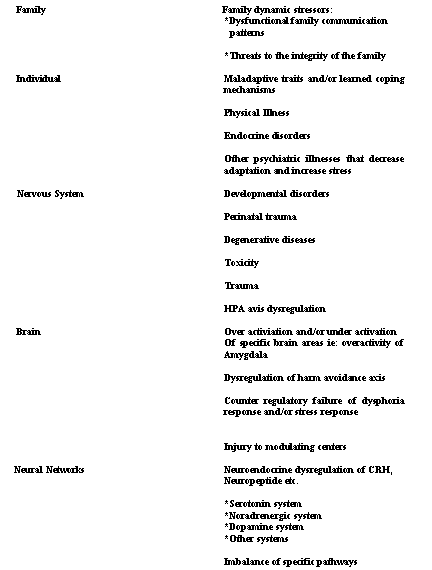

Note:
|
| The core symptoms of clinical depression
are modulation changes associated with emotional (limbic) and vegetative (brain
stem/hypothalamic) modulation changes. Core screening questions are: Emotional Modulation: Is there more dysphoria than is appropriate for the current life situation? Is there less capacity for pleasure for the daily activities of life than is appropriate for the current life situation? Vegetative Modulation: Is there a decline of normal eating patterns with abnormal patterns of appetite, satiation and food intake? Is there a decline of normal sleeping patterns with a loss of the normal 24-hour circadian rhythms resulting in not being well rested in the morning? Is there a decline of normal sexual functioning with a loss of normal interest and sexual functioning? Modulation of Perception: Is there a disproportionate focus on negative perceptions? Modulation of Motor Functioning: Is there an abnormal pattern of motor functioning such as psychomotor retardation (diminished physical activity) or agitation? Modulation of Processing: Is there excessive preoccupation on negative/adversive thoughts? If symptoms are present in these areas, a more thorough evaluation should then be performed with an assessment of the contributing factors in each system that can contribute toward depression. |
| A combination of psychotherapy and
antidepressants are the most common treatments for depression, although a very large
number of different treatments exist. Antidepressant treatments are most commonly
implemented when the vegetative symptoms of depression are present. Studies show that any
one antidepressant is effective in about 70% of patients. A large number of medications
are FDA approved for the treatment of depression and many medications which are not
formally approved are sometimes used to treat depression. The goal is to select the
treatment that is most effective and best tolerated for that individual. Since depression most commonly is comorbid and interacts with other somatic and mental diseases, the treatment of comorbid disease is a major consideration in choosing the most effective treatment. The newer, broad-spectrum psychotropics are often quite effective in treating both depression and comorbid/interactive mental illnesses. It is, therefore, a very individualized decision based on a thorough, confidential assessment. |
| As described, depression begins with an
adaptive modulation, which then becomes extreme, evolving into a pathological vicious
cycle; many loops are interconnected with failure of counter-regulatory (feedback)
systems. Likewise, other pathology in the harm avoidance pathway can be explained in a
similar manner. Much of what is currently called Obsessive-Compulsive Disorder can be
viewed as an excessive modulation shift in anticipation, often the anticipation of harm,
driving thoughts and behaviors in that direction. Obsessive-compulsive patients often
describe a period in the beginning of their illness when they first experience an
excessive amount of the emotion of anticipation of harm. The forcefulness of this emotion
then drives thought content and imagery towards harm-related subjects. Behaviors, habits
and compulsions are also driven towards what is perceived to be harm avoidance conduct.
There appears to be an imbalance between the pathways that drive anticipation of harm and
the feedback pathways, which inhibit this function. Compulsions are repetitive behavioral patterns that are a result of activity of the motivational system. For example, checking rituals are compulsions to relieve obsessions of pathological self-doubt, while cleaning rituals are compulsions to relieve obsession of contamination. Besides obsessions, there are other causes of compulsions. Some compulsions can be viewed as instinctual behaviors, i.e.: grooming, sex, nesting, hoarding, etc. Other compulsions are learned (habits) or instinctual behaviors, which are modified by learning. Tics and other movements are repetitive movements, which are also a part of the motion-emotion basal ganglia system. Dysfunction of the basal ganglia or its cerebral connections is associated with OCD. Dysfunction of the adjacent cingulate gyrus is associated with compromising the flexibility of response. In all probability, apathy is associated with a loss of activity of a stimulatory center, while obsessions, intrusive images, compulsions and tics are associated with a loss of activity of inhibitory centers. Excessive allocation of mental resources in these directions then results in pathological vicious cycles and the illness of obsessive-compulsive disorder.* |
| Panic is triggered by a perception of
imminent harm. There is a rapid acceleration of the alarm reaction. Thus, individuals with
the illness of panic disorder find this pathway triggered too readily by events that may
not warrant such a level of alarm. The counter regulating mechanisms fail to dampen the
speed of acceleration of the alarm reaction. Any fear can potentially trigger a panic
attack in a sensitized individual. Once someone experiences panic attacks, there is then
fear of the cues associated with triggering the panic attack, as well as a fear of the
attack itself. Once fear is triggered in a susceptible individual, they are increasingly
sensitized to the fear and the vicious cycle of fear, which ensues. This process occurs in
multiple systems simultaneously. The fear of the panic attack or the fear of the fear is
often greater than the fear of the cues, which are associated with triggering the attack. Like depression and obsessive-compulsive disorder, this may be another condition in which stimulatory pathways are out of balance with inhibitory pathways. Although pathology is caused by an imbalance of opposing stimulatory and inhibitory pathways, overactivity of a stimulatory center (as seen in a complex partial seizure disorder) is a less common cause of pathology. More commonly, there appears to be a failure of normal inhibitory (or feedback/counter-regulatory) control. |
| Fear can be evoked by a variety of
triggers. (See diagram: Fear Sequence). We are hypophobic if fear is not strong enough
given the threat that exists. In contrast, we are hyperphobic if fear is excessive. Many
fears are instinctually pre-programmed, i.e.: fear of physical harm, heights, closed
spaces and many interpersonal fears. In addition, learning also affects the nature of our
fears. A simple learned fear occurs when we associate something with harm. When the
learned fear is disproportionate to the threat, it is termed a simple phobia. These
learned fears may either increase or be separate and unrelated to instinctual fears. In
either case there is excessive fear and difficulty discriminating the level of threat
posed by certain cues. Posttraumatic Stress Disorder has some similarities to a simple learned phobia. Both are learned fears, however, post traumatic stress disorder is far more complex. When a traumatic event causes a posttraumatic stress disorder, the threat is less predictable, often involving trust assessment, and there is a greater level of fearful helplessness leading to a greater perception of vulnerability. The very high emotional arousal associated with this memory is difficult to process and integrate with other memory. As a result, the memory is not processed but instead is suppressed and repressed, disconnected from other memory and remains in an intensely undifferentiated emotional and painful form. This finding is demonstrated on PET and SPECT scans. Keeping the memory suppressed causes a significant change in coping mechanisms including avoidance, persistent fearful arousal and emotional numbing which further impair the capacity to adapt and contribute to retraumatization. The psychological changes further contribute to neurochemical and neuroanatomical changes. These changes lead to a pathological vicious cycle that results in the signs and symptoms associated with PTSD. In both PTSD and learned simple phobias there is an inability to extinguish a learned fear. Arginine-vasopressin is one of many neuromodulators associated with PTSD and inhibits the extinction of a learned fear. */** Arginine-vasopressin inhibits the extinction of a learned fear. Excessive activity of this pathway may contribute to the development of posttraumatic stress disorder. Anorexia Nervosa disorder, another learned fear, is also associated with elevated arginine vasopressin. posttraumatic Stress and anorexia show many similarities; anorexia nervosa may be viewed as a type of posttraumatic stress disorder. Both illnesses are associated with a genetic vulnerability. PTSD contributes to a significant amount of emotional distress, disability, impulse behavior and physical symptoms. The most concise, current review of PTSD is by B. van der Kolk, The Psychobiology of Posttraumatic Stress Disorder, J Clin Psychiatry.; 1997; 58 (sup 9) p. 16-24. |